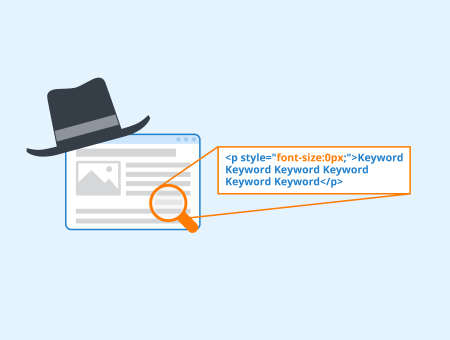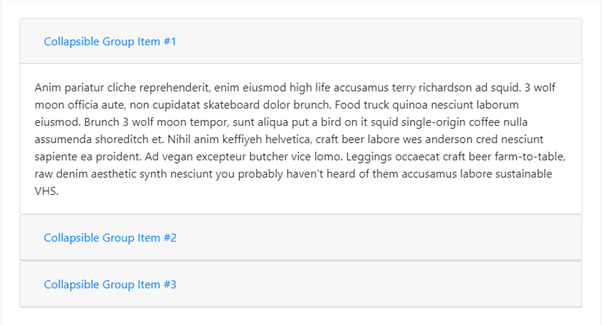Hidden content

Hidden content is all content that is hidden from website visitors but predominantly refers to text that’s hidden on a webpage and not visible on the user’s screen. Hidden content is often created by making the content the same color as the background or by setting the font size to zero, allowing search engine crawlers to view the content without it being visible on a user’s screen.
In the past, hidden content was used to add more content and keywords to pages without impacting the usability of the page. Nowadays, search engines like Google have been known to penalize webmasters who try to trick search engines using hidden content.
Hidden content & SEO history
Although hidden content is still used today in both black hat SEO as well as white hat SEO, it was first used by SEOs in the late nineties. By hiding long lists of keywords on a page, they tried to trick search engine algorithms into ranking their pages higher. Keywords used to be one of the most important ranking factors when search engines were still in their infancy, leading SEOs and webmasters to spam large quantities of keywords onto the page in a bid to improve rankings. By hiding the keywords, they could prevent long lists of keywords from being visible on their visitor’s screen and therefore maintain what appeared to be a normal page design.
Today, strategies for using hidden content are a lot more complex. Some of these are considered black hat and are against Google’s guidelines. Others are used to improve the usability of a page, which is in accordance with their guidelines and actually encouraged by Google.[1]

An example of hidden content that’s in accordance with Google guidelines (a collapse menu where the content in each tab is hidden) as seen on getbootstrap.com
There are two main types of hidden content that are used by SEOs or have been used by them in the past. These are hidden text and hidden links.
Hidden text is a way of adding more content to a page without it being visible on the website visitor’s screen. Hidden text was previously used for adding more keywords onto a page, which used to be a good way of improving your search rankings. This is a form of keyword stuffing.
Hidden links add backlinks to pages without them being visible to website visitors and were used for improving the search performance of the pages the links pointed to.
Both of these SEO techniques are generally classed as black hat SEO, although some forms of hidden text are accepted as white hat. An example of this is alt-text, which is also not visible on the screen but can be used by screen reading software for accessibility and to add context.
Today, hidden text is still used by a large number of websites to improve the user experience. Text in dropdown menus, accordions, and other elements can reduce the amount of content visible on a user’s screen while still providing a substantial amount of information. Google still crawls this content and doesn’t penalize it since it is beneficial to the user. Schema markup and alt-text are other examples of hidden content that’s in accordance with Google guidelines.

An example of alt text on the Seobility blog.
Penalties for Using Hidden Content
Search engines can detect and penalize websites that employ hidden content for manipulative SEO practices. Google, in particular, has been known to issue penalties ranging from demotion in search rankings to complete de-indexing of websites found to be using hidden content in a deceptive manner. Hidden text and links are covered in detail in their spam policies[2]. These penalties serve as a deterrent, ensuring that webmasters adhere to ethical SEO practices and maintain a level playing field.
Accessibility and Hidden Content
While hidden content has traditionally been associated with SEO manipulation, it also plays a crucial role in web accessibility. Screen readers and other assistive technologies rely on hidden content to provide context and navigation cues to users with visual impairments. For instance, off-screen text that’s invisible to sighted users can be instrumental in describing images (alt-text) or providing additional context for users of screen readers (ARIA (Accessible Rich Internet Applications) attributes). This form of hidden content enhances the user experience without compromising the visual aesthetics of a website and is considered white hat.

An example of the aria-label on a contact button with unclear button text.
Current-day SEO implications
Hidden content that tries to manipulate the algorithm is still used by black hat SEOs in order to try and trick search engine algorithms into ranking pages higher. This type of hidden content is penalized by search engines if they discover it and is not generally a part of a white hat SEO campaign.
That being said, hidden content can be used to improve a website’s user experience or help search engines understand a page. This type of hidden content, like alt text, schema markup and content hidden inside of dropdown menus, complies with Google’s guidelines and is not penalized. These forms of hidden content can actually improve your SEO performance and are considered best-practice if implemented correctly.
References
- ↑ Hidden text and links Google Search Central. Retrieved 09 January 2021.
- ↑ Google search spam policies Google Search Central. Retrieved 05 Nov 2023.
Related links
- https://developers.google.com/search/docs/advanced/guidelines/hidden-text-links
- https://www.searchenginejournal.com/hidden-text-seo/208866/
Similar articles
